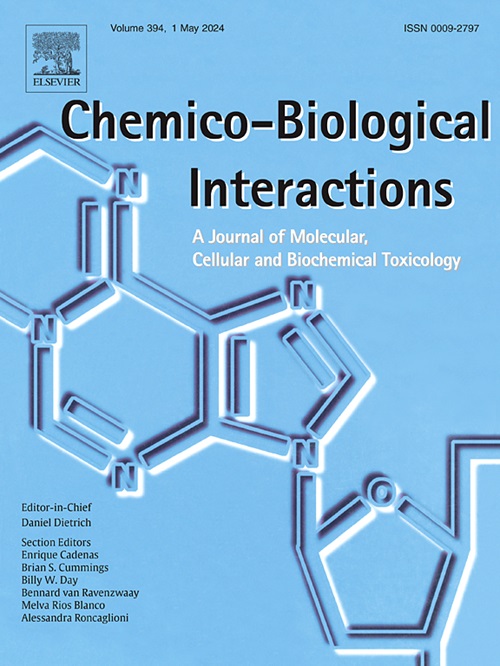Synergistic anti-hypernociceptive interaction between morphine and JM-20 in neuropathic rats. Mechanistic insights into metabolism, transport, and safety
IF 4.7
2区 医学
Q1 BIOCHEMISTRY & MOLECULAR BIOLOGY
引用次数: 0
Abstract
This study evaluated the anti-hypernociceptive interaction between morphine and the neuroprotective compound 3-ethoxycarbonyl-2-methyl-4-(2-nitrophenyl)-4,11-dihydro-1H-pyrido[2,3-b][1,5]benzodiazepine (JM-20) in neuropathic rats. Single and repeated co-administration of both drugs was assessed using the chronic constriction injury (CCI) model, via subcutaneous and oral routes. Isobolographic analysis was performed to determine the nature of the pharmacological interaction. In addition, in silico pharmacokinetic and toxicological profiling was conducted, and JM-20's effects on human UDP-glucuronosyltransferase (UGT) and cytochrome P450 (CYP) enzyme systems were evaluated in vitro.
Morphine, JM-20, and their 1:1 fixed-ratio combinations significantly attenuated mechanical hypersensitivity in a dose-dependent manner. The observed ED50 for the combination (2.15 ± 0.07 mg/kg) was significantly lower than the theoretical additive ED50 (8.05 ± 0.58 mg/kg), indicating a synergistic interaction. Repeated morphine administration led to tolerance, while the morphine:JM-20 combination maintained efficacy for 14 days and prevented morphine-induced facilitation of neuropathic hypersensitivity.
JM-20 did not alter UGT activity, suggesting no interference with morphine glucuronidation or active metabolite formation. However, JM-20 strongly inhibited CYP3A4 and other major CYP isoforms (1A, 2C9, 2D6, 2A6), potentially relevant for interactions with co-administered drugs, though not with morphine. JM-20 may also inhibit P-glycoprotein, possibly enhancing morphine's central bioavailability. In silico and in vitro analyses indicated a potential risk of cardiotoxicity and hepatotoxicity.
Overall, JM-20 enhances morphine analgesia in neuropathic pain, but further in vivo studies are required to evaluate the long-term safety of this combination.
神经病变大鼠吗啡与JM-20的协同抗痛觉作用代谢、运输和安全的机械洞察。
本研究评价了吗啡与神经保护化合物3-乙氧羰基-2-甲基-4-(2-硝基苯基)-4,11-二氢- 1h -吡啶[2,3-b][1,5]苯二氮卓(JM-20)在神经病大鼠体内抗高痛觉性的相互作用。采用慢性收缩损伤(CCI)模型,通过皮下和口服两种途径对两种药物的单次和重复联合给药进行评估。进行等密度分析以确定药理学相互作用的性质。此外,进行了体外药代动力学和毒理学分析,并评价了JM-20对人udp -葡萄糖醛酸糖基转移酶(UGT)和细胞色素P450 (CYP)酶系统的影响。吗啡、JM-20及其1:1固定比例组合呈剂量依赖性,显著减弱机械超敏反应。联合用药ED50(2.15±0.07 mg/kg)显著低于理论加药ED50(8.05±0.58 mg/kg),表明两者存在协同作用。吗啡:JM-20联合用药可维持14天的疗效,并可阻止吗啡诱导的神经性超敏反应的促进。JM-20不改变UGT活性,提示对吗啡糖醛酸化或活性代谢物形成有任何干扰。然而,JM-20强烈抑制CYP3A4和其他主要的CYP亚型(1A, 2C9, 2D6, 2A6),这可能与联合给药药物相互作用有关,尽管与吗啡无关。JM-20也可能抑制p糖蛋白,可能提高吗啡的中枢生物利用度。在计算机和体外分析表明,心脏毒性和肝毒性的潜在风险。总体而言,JM-20增强了吗啡对神经性疼痛的镇痛作用,但需要进一步的体内研究来评估该组合的长期安全性。
本文章由计算机程序翻译,如有差异,请以英文原文为准。
求助全文
约1分钟内获得全文
求助全文
来源期刊
CiteScore
7.70
自引率
3.90%
发文量
410
审稿时长
36 days
期刊介绍:
Chemico-Biological Interactions publishes research reports and review articles that examine the molecular, cellular, and/or biochemical basis of toxicologically relevant outcomes. Special emphasis is placed on toxicological mechanisms associated with interactions between chemicals and biological systems. Outcomes may include all traditional endpoints caused by synthetic or naturally occurring chemicals, both in vivo and in vitro. Endpoints of interest include, but are not limited to carcinogenesis, mutagenesis, respiratory toxicology, neurotoxicology, reproductive and developmental toxicology, and immunotoxicology.

 求助内容:
求助内容: 应助结果提醒方式:
应助结果提醒方式:


